Search Result
Results for "
swelling
" in MedChemExpress (MCE) Product Catalog:
6
Isotope-Labeled Compounds
| Cat. No. |
Product Name |
Target |
Research Areas |
Chemical Structure |
-
- HY-B1183
-
-

-
- HY-13681
-
|
|
Glucocorticoid Receptor
|
Inflammation/Immunology
|
|
Methylprednisolone acetate, a prednisolone derivative, is a corticosteroid hormone. Methylprednisolone acetate can relieve pain and swelling that occurs with arthritis and other joint disorders in vivo .
|
-

-
- HY-P2275B
-
-

-
- HY-155551
-
|
|
NO Synthase
|
Inflammation/Immunology
|
|
Anti-inflammatory agent 46 (compound 7h) is an anti-inflammatory agent with nitric oxide (NO) inhibitory effect. Anti-inflammatory agent 46 binds to iNOS with low energies, inhibits swelling in mice (at dose of 10 mg/kg) .
|
-
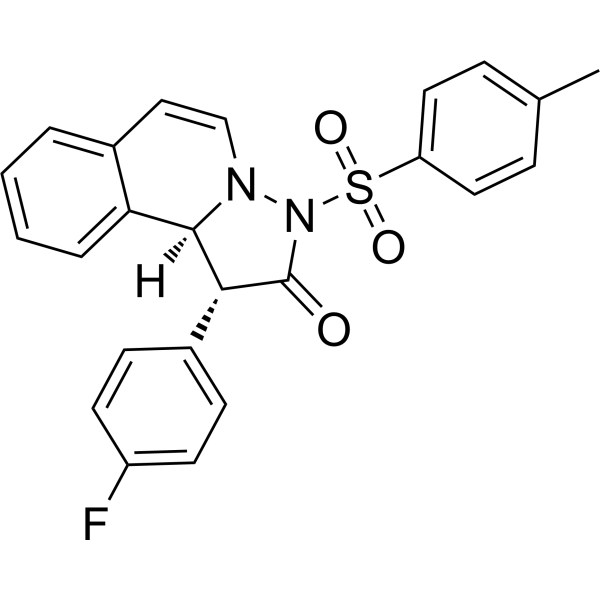
-
- HY-151503
-
|
|
Autophagy
|
Cancer
|
|
MPM-1, a marine Eusynstyelamides mimic, is a potent anticancer agent. MPM-1 can rapidly kill cancer cells in vitro by inducing a necrosis-like death. MPM-1 has the ability to induce immunogenic cell death. MPM-1 causes perturbation of autophagy and lysosomal swelling in cancer cells .
|
-

-
- HY-103371
-
DCPIB
5 Publications Verification
|
Chloride Channel
Potassium Channel
|
Neurological Disease
|
|
DCPIB is a selective, reversible and potent inhibitor of volume-regulated anion channels (VRAC). DCPIB voltage-dependently activates potassium channels TREK1 and TRAAK, and inhibits TRESK, TASK1 and TASK3 (IC50s: 0.14, 0.95, 50.72 μM, respectively). DCPIB is also a selective blocker of swelling-induced chloride current (ICl,swell), with an IC50 of 4.1 μM. DCPIB is a useful tool for investigating structure-function studies of K2P channels .
|
-

-
- HY-136642
-
|
|
Others
|
Inflammation/Immunology
|
|
Fluocinolone is a corticosteroid that is used to relieve redness, itching, swelling, or other discomfort caused by skin conditions .
|
-

-
- HY-107855S
-
|
(±)-Mevalonolactone-d7; Mevalolactone-d7
|
Endogenous Metabolite
|
Metabolic Disease
|
|
DL-Mevalonolactone-d7 is the deuterium labeled DL-Mevalonolactone. DL-Mevalonolactone ((±)-Mevalonolactone) is the δ-lactone form of mevalonic acid, a precursor in the mevalonate pathway. DL-Mevalonolactone (Mevalonolactone) decreases mitochondrial membrane potential (∆Ψm), NAD(P)H content and the capacity to retain Ca2+ in the brain, besides inducing mitochondrial swelling[1][2].
|
-

-
- HY-107855S1
-
|
(±)-Mevalonolactone-d3; Mevalolactone-d3
|
Endogenous Metabolite
|
Metabolic Disease
|
|
DL-Mevalonolactone-d3 is the deuterium labeled DL-Mevalonolactone[1]. DL-Mevalonolactone ((±)-Mevalonolactone;Mevalolactone) is the δ-lactone form of mevalonic acid, a precursor in the mevalonate pathway. DL-Mevalonolactone (Mevalonolactone) decreases mitochondrial membrane potential ( Ψm), NAD(P)H content and the capacity to retain Ca2+ in the brain, besides inducing mitochondrial swelling[2][3].
|
-

-
- HY-P2275
-
-
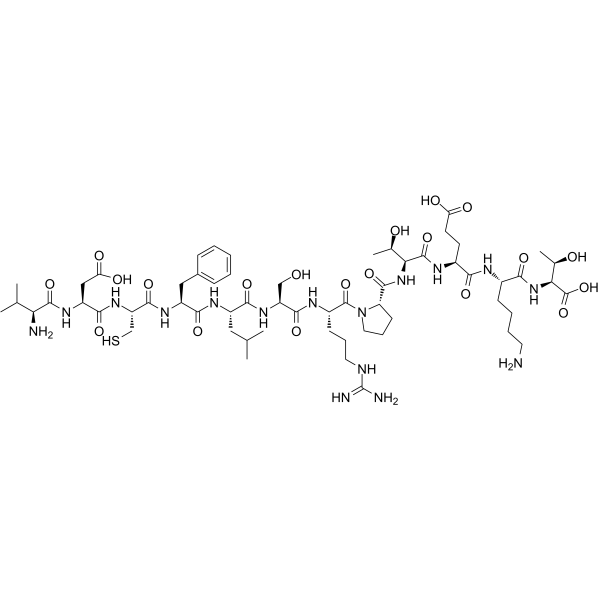
-
- HY-145726
-
|
|
TNF Receptor
|
Inflammation/Immunology
|
|
ISIS 104838 is an antisense oligonucleotide agent that reduces the production of tumor necrosis factor (TNF-alpha), a substance that contributes to joint pain and swelling in rheumatoid arthritis.
|
-

-
- HY-145726A
-
|
|
TNF Receptor
|
Inflammation/Immunology
|
|
ISIS 104838 sodium is an antisense oligonucleotide agent that reduces the production of tumor necrosis factor (TNF-alpha), a substance that contributes to joint pain and swelling in rheumatoid arthritis.
|
-
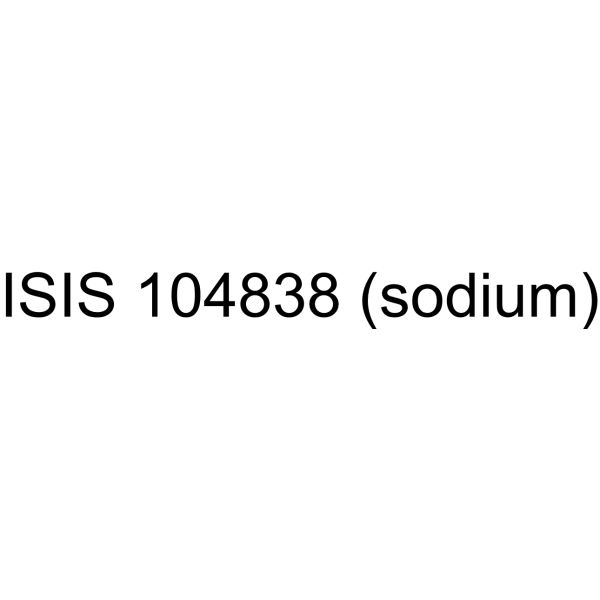
-
- HY-149961
-
|
|
Parasite
|
Infection
Inflammation/Immunology
|
|
Anti-inflammatory agent 40 is a potential and orally active anti-malarial and anti-inflammatory agent. Anti-inflammatory agent 40 inhibits carrageenan induced paw swelling in vivo.
|
-

-
- HY-N2109
-
|
|
Others
|
Metabolic Disease
|
|
Macranthoidin A is an orally active saponin from Flos Lonicerae. Macranthoidin A possess protection effects on hepatic injury caused by Acetaminophen, Cd, and CCl4, and conspicuous depressant effects on swelling of ear croton oil .
|
-
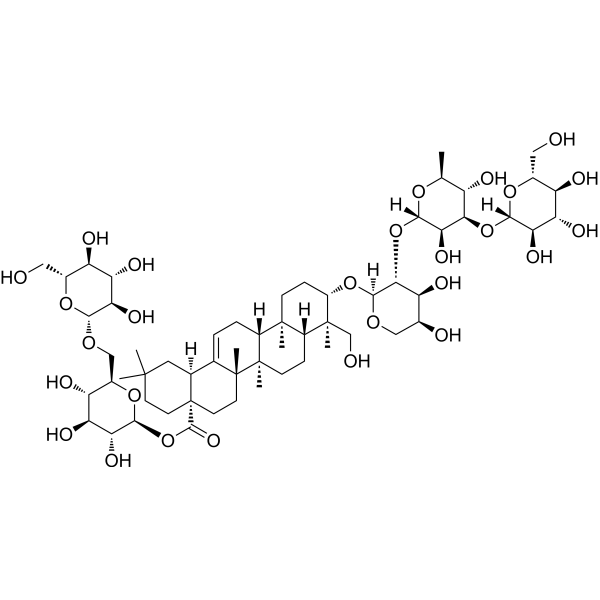
-
- HY-134820
-
|
|
MALT1
|
Inflammation/Immunology
|
|
MLT-943 is a potent, selective and orally active MALT1 protease inhibitor. MLT-943 inhibits stimulated-IL-2 secretion in PBMC or in whole blood with a similar IC50 across species (0.07-0.09 μM in PBMC, 0.6-0.8 μM in whole blood). MLT-943 has anti-inflammatory activities and can be used for FcgR-mediated inflammation research .
|
-

-
- HY-13681R
-
|
|
Glucocorticoid Receptor
|
Inflammation/Immunology
|
|
Methylprednisolone acetate (Standard) is the analytical standard of Methylprednisolone acetate. This product is intended for research and analytical applications. Methylprednisolone acetate, a prednisolone derivative, is a corticosteroid?hormone. Methylprednisolone acetate can relieve pain and swelling that occurs with arthritis and other joint disorders in vivo .
|
-
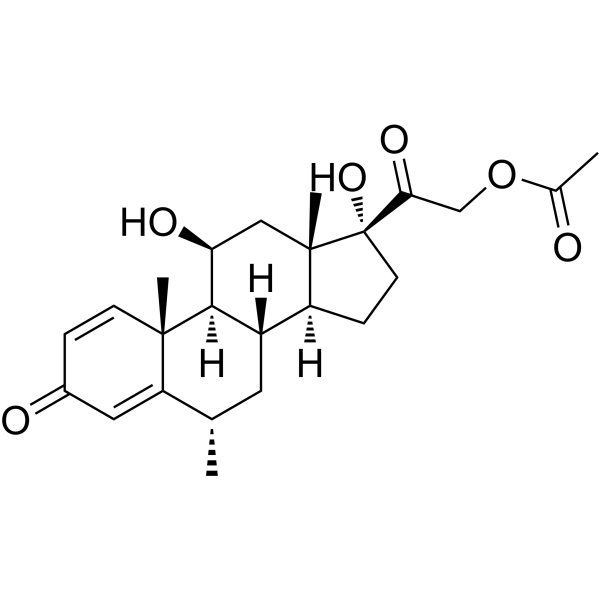
-
- HY-13681S
-
|
|
Glucocorticoid Receptor
Isotope-Labeled Compounds
|
Inflammation/Immunology
|
|
Methylprednisolone acetate-d6 is the deuterium labeled Methylprednisolone acetate (HY-13681). Methylprednisolone acetate, a prednisolone derivative, is a corticosteroid hormone. Methylprednisolone acetate can relieve pain and swelling that occurs with arthritis and other joint disorders in vivo .
|
-
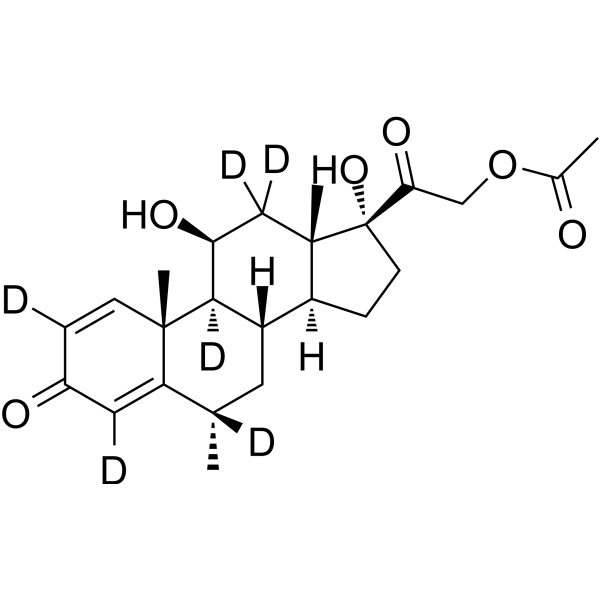
-
- HY-W121901
-
|
(S)-Naproxen-β-D-glucuronide
|
COX
|
Inflammation/Immunology
|
|
Naproxen glucuronide ((S)-Naproxen-β-D-glucuronide) is a non-selective COX inhibitor. Naproxen glucuronide, a metabolite of naproxen, is a nonsteroidal anti-inflammatory drug (NSAID) of the propionic acid class (the same as ibuprofen) that relieves pain, fever, swelling, and stiffness .
|
-

-
- HY-10794
-
-
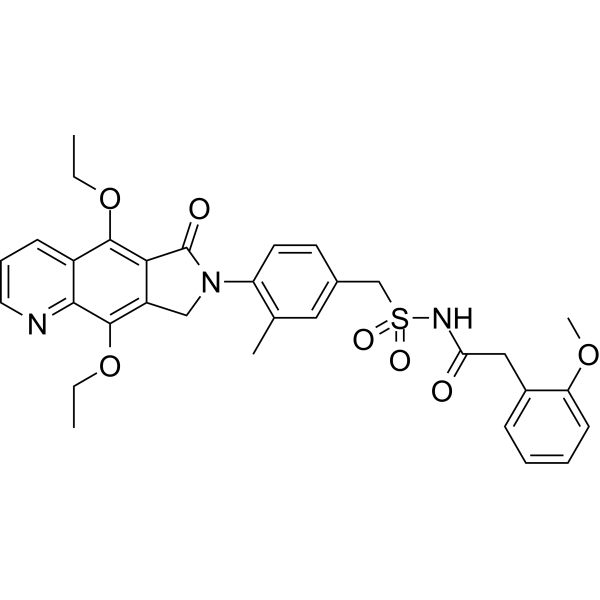
-
- HY-P99248
-
|
Risankizumab rzaa; BI 655066
|
Interleukin Related
|
Inflammation/Immunology
|
|
Risankizumab (BI 655066) is a humanised IgG monoclonal antibody, targeting IL-23 p19 subunit (Kd <10 pM) and inhibiting IL-17 production induced by human IL-23 in mouse splenocytes (IC50 = 2 pM). Risankizumab can be used to research immunological and inflammatory disorders such as psoriasis vulgaris, psoriatic arthritis, generalized pustular psoriasis and erythrodermic psoriasis .
|
-

-
- HY-N8228
-
|
|
Bacterial
|
Infection
Inflammation/Immunology
Cancer
|
|
17-Hydroxyneomatrine, extracted from Sophora flavescens, can well inhibit the growth of human cervical carcinoma Hela cells, has the wide-range antibacterial, anti-allergy, anti-tumor, anti-arrhythmia, swelling-subsiding diuresis, immunizing, and biological regulation functions .
|
-
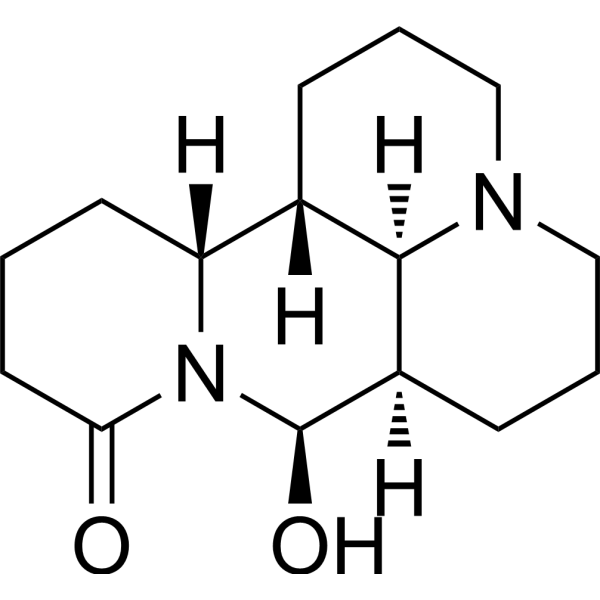
-
- HY-B1456A
-
|
LILLY-53858
|
|
|
|
Fenoprofen (LILLY-53858) is a nonsteroidal anti-inflammatory agent (NSAID). Fenoprofen can be used to to relieve symptoms of arthritis (osteoarthritis and rheumatoid arthritis), such as inflammation, swelling, stiffness, and joint pain. Fenoprofen is an allosteric enhancer for melanocortin receptors. Fenoprofen also increases ERK1/2 activation .
|
-
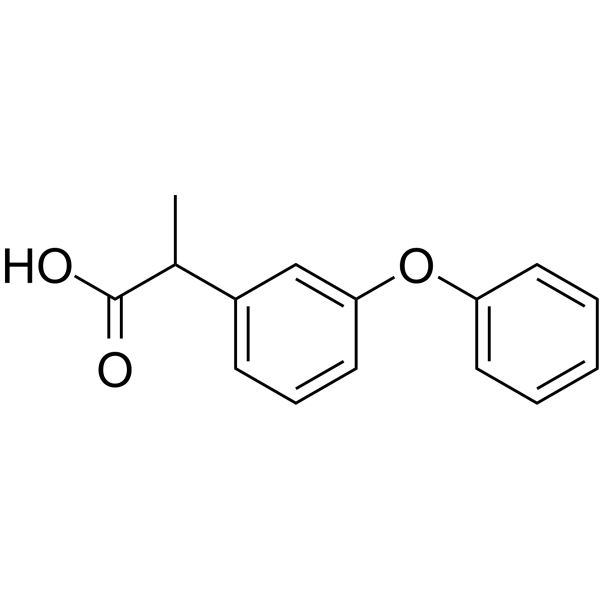
-
- HY-157121
-
|
|
JAK
|
Inflammation/Immunology
|
JAK-IN-34 (compound 11n) is a potent against of JAKs with IC50 values of 0.40, 0.83, 2.10, 1.95 nM target JAK1, JAK2, JAK3, TYK2, respectively. JAK-IN-34 reduces joint swelling with good safety .
|
-
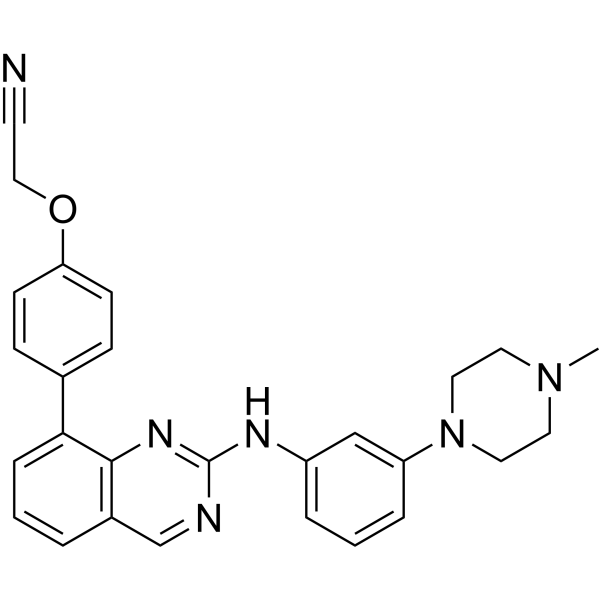
-
- HY-107855
-
|
(±)-Mevalonolactone; Mevalolactone
|
Endogenous Metabolite
|
Metabolic Disease
Inflammation/Immunology
|
|
DL-Mevalonolactone ((±)-Mevalonolactone;Mevalolactone) is the δ-lactone form of mevalonic acid, a precursor in the mevalonate pathway. DL-Mevalonolactone is orally active against HMGCR mutation and statin caused myopathy . DL-Mevalonolactone induces inflammation and oxidative stress response with decreased mitochondrial membrane potential (MMP) and induces mitochondrial swelling [2][4].
|
-

-
- HY-109127A
-
|
BCX7353 dihydrochloride
|
Ser/Thr Protease
|
Others
|
|
Berotralstat dihydrochloride is a low toxicity, effective, highly specific, second-generation, synthetic and orally active plasma kallikrein inhibitor used for the research of hereditary angioedema (HAE) attacks. Berotralstat dihydrochloride works by blocking the enzymatic activity of plasma kallikrein in releasing bradykinin, the major biologic peptide that promotes swelling and pain associated with attacks of HAE .
|
-
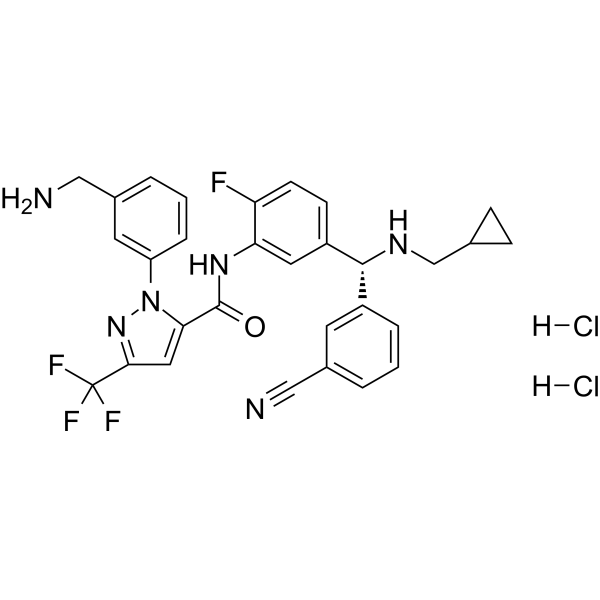
-
- HY-18759
-
|
|
p38 MAPK
TNF Receptor
|
Inflammation/Immunology
|
|
BMS-751324 is a p38α MAPK inhibitor. BMS-751324 equips a precursor of carbamyl-methyl linkage, containing esters and phosphate functional groups derived from hydroxyphenylacetic acid (HPA). BMS-751324 effectively inhibits foot swelling and LPS-induced TNFα production in an arthritic rat model .
|
-

-
- HY-158116
-
|
RO7589831; VVD-133214
|
DNA/RNA Synthesis
|
Cancer
|
|
VVD-214 is a synthetic lethal allosteric inhibitor of WRN helicase. VVD-214 covalently binds to cysteine 727 of WRN and inhibits ATP hydrolysis and helicase activity. VVD-214 is potent in causing double-stranded DNA breaks, nuclear swelling, and cell death in high microsatellite instability (MSI) cancers.
|
-

-
- HY-N4104
-
|
Agaricinic Acid
|
Mitochondrial Metabolism
|
Metabolic Disease
|
|
Agaric acid (Agaricinic Acid) is obtained from various plants of the fungous tribe, i.e. Polyporus officinalis and Polyporus igniarius. Agaric acid induces mitochondrial permeability transition through its interaction with the adenine nucleotide translocase. Agaric acid promotes efflux of accumulated Ca 2+, collapse of transmembrane potential, and mitochondrial swelling. Agaric acid is used to regulate lipid metabolism .
|
-
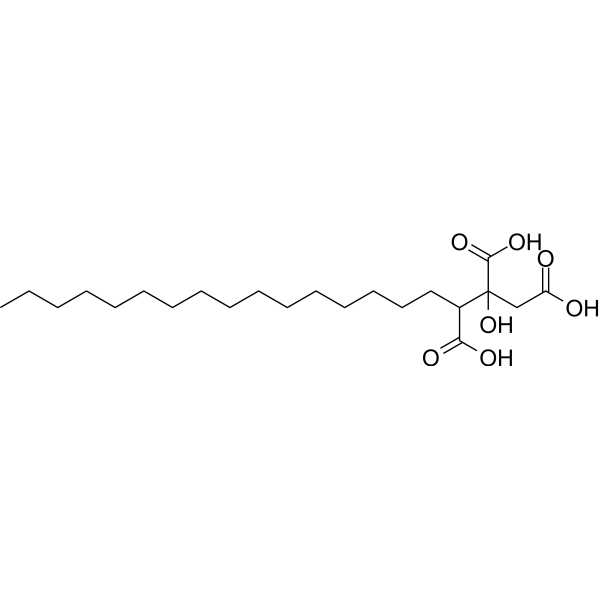
-
- HY-109127
-
|
BCX7353
|
Ser/Thr Protease
|
Others
|
|
Berotralstat (BCX7353) is a low toxicity, effective, highly specific, second-generation, synthetic and orally active plasma kallikrein inhibitor used for the research of hereditary angioedema (HAE) attacks. Berotralstat works by blocking the enzymatic activity of plasma kallikrein in releasing bradykinin, the major biologic peptide that promotes swelling and pain associated with attacks of HAE .
|
-

-
- HY-78131C
-
|
(±)-Ibuprofen sodium
|
COX
Apoptosis
Parasite
|
Infection
Neurological Disease
Inflammation/Immunology
Cancer
|
|
Ibuprofen ((±)-Ibuprofen) sodium is an orally active, selective COX-1 inhibitor with an IC50 value of 13 μM. Ibuprofen sodium inhibits cell proliferation, angiogenesis, and induces cell apoptosis. Ibuprofen sodium is a nonsteroidal anti-inflammatory agent and a nitric oxide (NO) donor. Ibuprofen sodium can be used in the research of pain, swelling, inflammation, infection, immunology, cancers .
|
-

-
- HY-149985
-
|
|
Parasite
|
Infection
|
|
Antitrypanosomal agent 12 is a C20-phenylthiourea with trypanocidal and cytotoxic activities. Antitrypanosomal agent 12 shows antitrypanosomal activity with 50% growth inhibition (GI50) values of 0.22 μM. Antitrypanosomal agent 12 induces faster cell swelling in bloodstream-form trypanosomes than Salinomycin (HY-15597) .
|
-
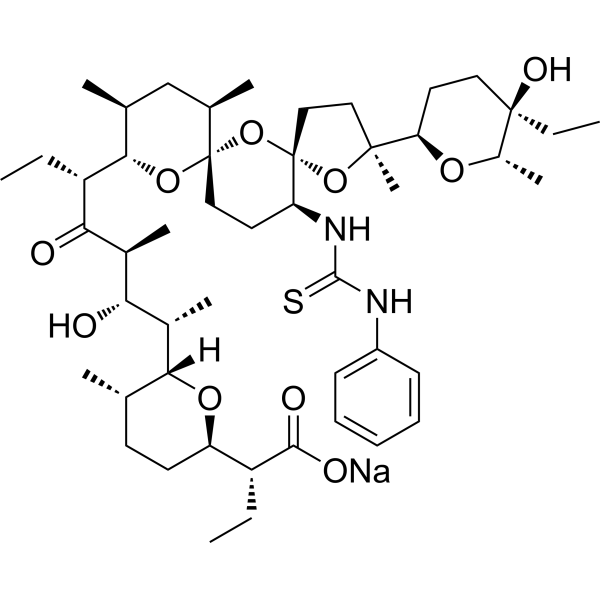
-
- HY-78131
-
Ibuprofen
Maximum Cited Publications
11 Publications Verification
(±)-Ibuprofen
|
COX
Apoptosis
Parasite
|
Infection
Neurological Disease
Inflammation/Immunology
Cancer
|
|
Ibuprofen ((±)-Ibuprofen) is a potent, orally active, selective COX-1 inhibitor with an IC50 value of 13 μM. Ibuprofen inhibits cell proliferation, angiogenesis, and induces cell apoptosis. Ibuprofen is a nonsteroidal anti-inflammatory agent and a nitric oxide (NO) donor. Ibuprofen ((±)-Ibuprofen) can be used in the research of pain, swelling, inflammation, infection, immunology, cancers .
|
-

-
- HY-N2274
-
|
12-Oleanene-3β,16β,23,28-tetrol; 3β,16β-12-Oleanene-3, 16,23,28-tetrol
|
|
|
|
23-Hydroxylongispinogenin (12-Oleanene-3β,16β,23,28-tetrol) is extracted from Lysimachia heterogenea Klatt. Lysimachia heterogenea Klatt is a perennial herb, which is used as a folk medicine in subduing swelling and detoxicating in China. The effective fraction LH-1 of L. heterogene has antitumor activity .
|
-
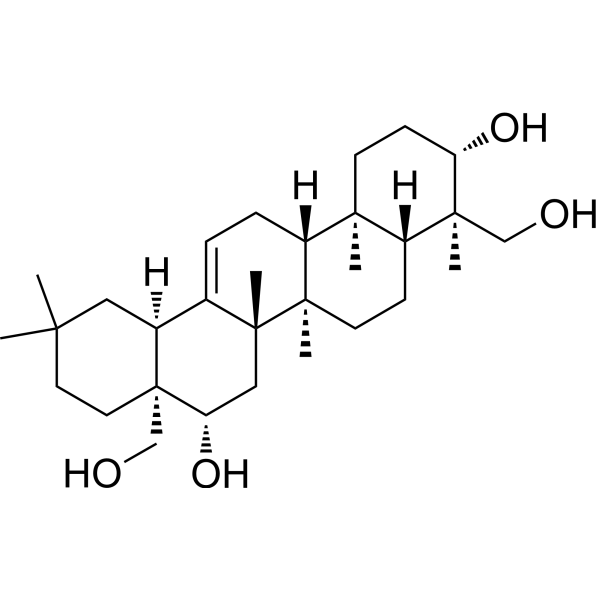
-
- HY-B1456AS
-
|
|
Isotope-Labeled Compounds
Melanocortin Receptor
|
Inflammation/Immunology
|
|
Fenoprofen- 13C6 (sodium hydrate) is the 13C labeled Fenoprofen (HY-B1456A). Fenoprofen is a nonsteroidal anti-inflammatory agent (NSAID). Fenoprofen can be used to to relieve symptoms of arthritis (osteoarthritis and rheumatoid arthritis), such as inflammation, swelling, stiffness, and joint pain. Fenoprofen is an allosteric enhancer for melanocortin receptors. Fenoprofen also increases ERK1/2 activation[1][2][3].
|
-
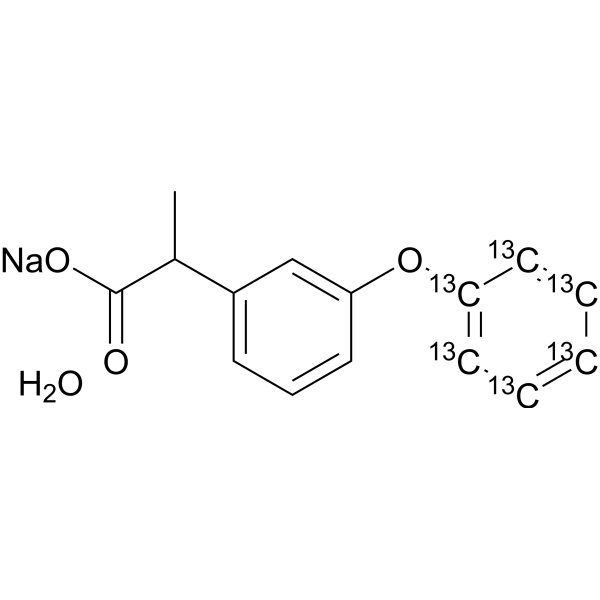
-
- HY-78131S2
-
|
|
Apoptosis
COX
Parasite
|
|
|
Ibuprofen-d4 is a potent, orally active, selective COX-1 inhibitor with an IC50 value of 13 μM. Ibuprofen inhibits cell proliferation, angiogenesis, and induces cell apoptosis. Ibuprofen is a nonsteroidal anti-inflammatory agent and a nitric oxide (NO) donor. Ibuprofen ((±)-Ibuprofen) can be used in the research of pain, swelling, inflammation, infection, immunology, cancers[2][3][4][5].
|
-

-
- HY-105064D
-
|
CP-597396 hydrochloride hydrate
|
Na+/H+ Exchanger (NHE)
|
Cardiovascular Disease
|
|
Zoniporide (CP-597396) hydrochloride hydrate is a potent and selective inhibitor of sodium-hydrogen exchanger type 1 (NHE-1). Zoniporide hydrochloride hydrate inhibits human NHE-1 (IC50=14 nM), and has >150-fold selectivity versus other NHE isoforms. Zoniporide hydrochloride hydrate potently inhibits ex vivo NHE-1-dependent swelling of human platelets (IC50=59 nM) .
|
-
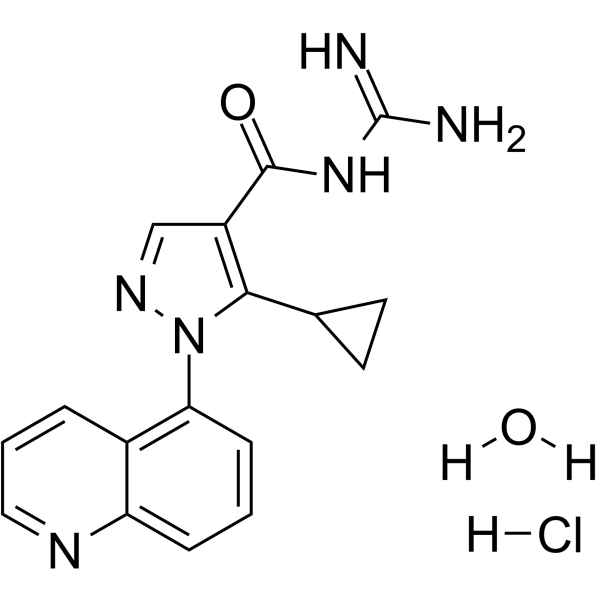
-
- HY-105064B
-
|
CP-597396 hydrochloride
|
Na+/H+ Exchanger (NHE)
|
Cardiovascular Disease
|
|
Zoniporide (CP-597396) hydrochloride is a potent and selective inhibitor of sodium-hydrogen exchanger type 1 (NHE-1). Zoniporide hydrochloride inhibits human NHE-1 (IC50=14 nM), and has >150-fold selectivity versus other NHE isoforms. Zoniporide hydrochloride potently inhibits ex vivo NHE-1-dependent swelling of human platelets (IC50=59 nM) .
|
-
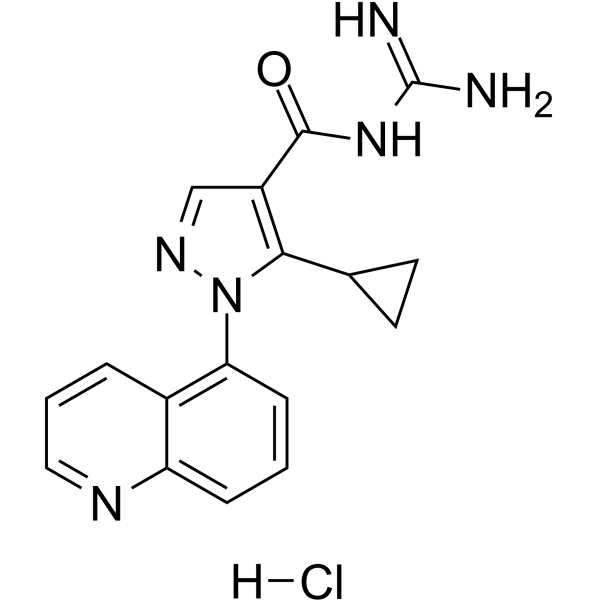
-
- HY-100586
-
|
(±)-Ibuprofen L-lysine
|
|
|
|
Ibuprofen ((±)-Ibuprofen) L-lysine is a potent orally active, selective COX-1 inhibitor with an IC50 value of 13 μM. Ibuprofen L-lysine inhibits cell proliferation, angiogenesis, and induces cell apoptosis. Ibuprofen L-lysine is a nonsteroidal anti-inflammatory agent and a nitric oxide (NO) donor. Ibuprofen L-lysine can be used in the research of pain, swelling, inflammation, infection, immunology, cancers .
|
-
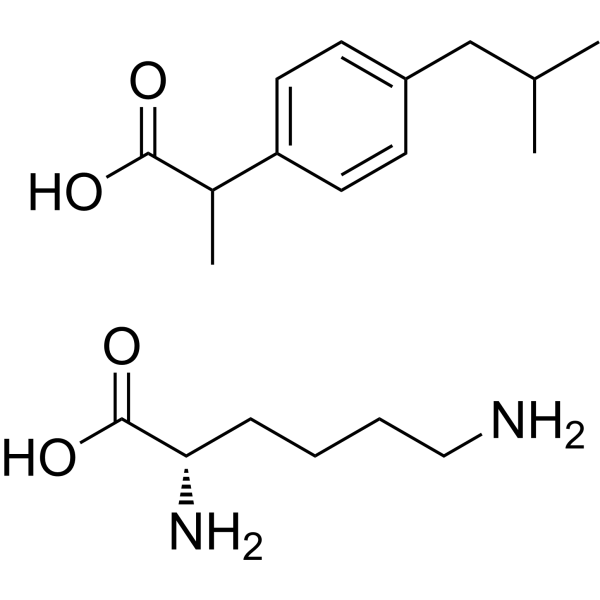
-
- HY-162011
-
|
|
EBI2/GPR183
|
Inflammation/Immunology
|
|
GPR183 antagonist-2 (compound 32) is a selective GPR183 antagonist with good water solubility and excellent pharmacokinetic properties. GPR183 antagonist-2 significantly reduces paw and joint swelling and gene expression of pro-inflammatory cytokines (MCP-1, MMPs, and VEGF) in a collagen-induced arthritis (CIA) mouse model in a dose-dependent manner. GPR183 antagonist-2 can be used in the study of autoimmune diseases .
|
-

-
- HY-78131S3
-
|
(±)-Ibuprofen-13C6
|
Isotope-Labeled Compounds
|
Cancer
|
|
Ibuprofen- 13C6 ((±)-Ibuprofen- 13C6) is a 13C labeled Ibuprofen (HY-78131). Ibuprofen ((±)-Ibuprofen) is a potent, orally active, selective COX-1 inhibitor with an IC50 value of 13 μM. Ibuprofen inhibits cell proliferation, angiogenesis, and induces cell apoptosis. Ibuprofen is a nonsteroidal anti-inflammatory agent and a nitric oxide (NO) donor. Ibuprofen ((±)-Ibuprofen) can be used in the research of pain, swelling, inflammation, infection, immunology, cancers .
|
-

-
- HY-18071
-
BI-9627
1 Publications Verification
|
Na+/H+ Exchanger (NHE)
|
Cardiovascular Disease
|
|
BI-9627 is potent sodium-hydrogen exchanger isoform 1 (NHE1) inhibitor, with IC50s of 6 and 31 nM in intracellular pH recovery (pHi) and human platelet swelling assays, respectively. BI-9627 displays >30-fold selectivity against NHE2 and with no measurable inhibitory activity against the NHE3 isoform. BI-9627 shows low DDI (agent-agent interaction) potential, excellent pharmacokinetics in rat and dog, and remarkably potent activity in the isolated heart model of ischemia-reperfusion injury .
|
-
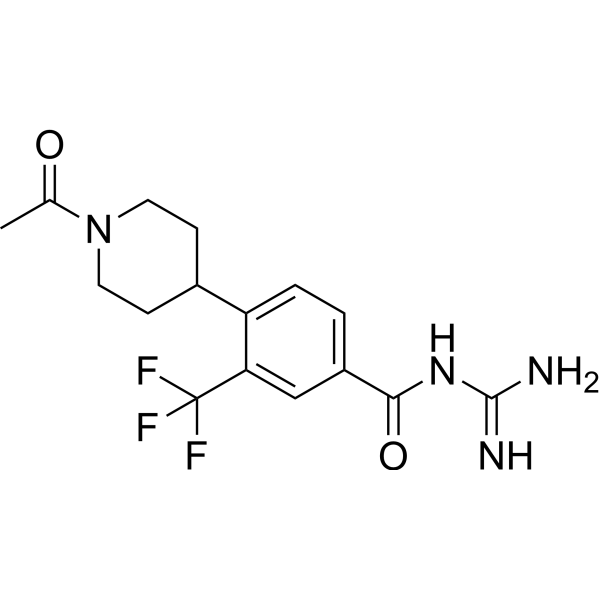
-
- HY-18071A
-
|
|
Na+/H+ Exchanger (NHE)
|
Cardiovascular Disease
|
|
BI-9627 hydrochloride is potent sodium-hydrogen exchanger isoform 1 (NHE1) inhibitor, with IC50s of 6 and 31 nM in intracellular pH recovery (pHi) and human platelet swelling assays, respectively. BI-9627 hydrochloride displays >30-fold selectivity against NHE2 and with no measurable inhibitory activity against the NHE3 isoform. BI-9627 hydrochloride shows low DDI (agent-agent interaction) potential, excellent pharmacokinetics in rat and dog, and remarkably potent activity in the isolated heart model of ischemia-reperfusion injury .
|
-
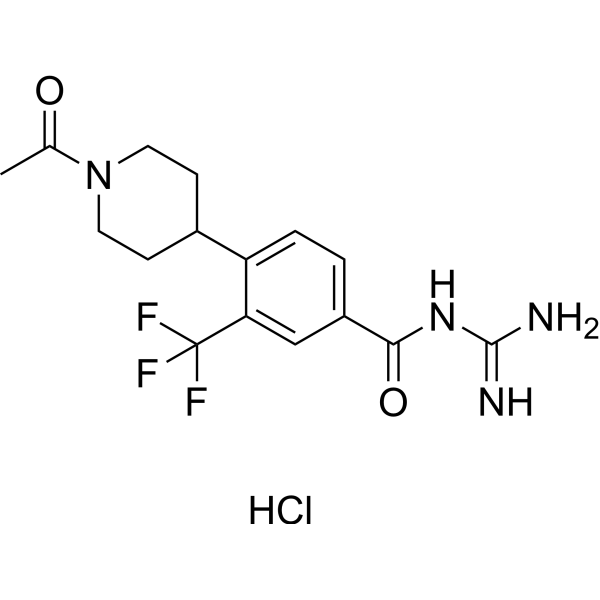
-
-
HY-L144
-
|
|
583 compounds
|
|
Normal mitochondrial function is critical for maintaining cellular homeostasis because mitochondria produce ATP and are the major intracellular source of free radicals. Cellular dysfunctions induced by intracellular or extracellular insults converge on mitochondria and induce a sudden increase in permeability on the inner mitochondrial membrane, the so-called mitochondrial membrane permeability transition (MMPT). MMPT is caused by the opening of pores in the inner mitochondrial membrane, matrix swelling, and outer membrane rupture. The MMPT is an endpoint to initiate cell death because the pore opening together with the release of mitochondrial cytochrome c activates the apoptotic pathway of caspases.
The normal operation of mitochondrial function is important for maintaining normal cell death and treatment of mitochondrial diseases. MCE offers a unique collection of 583 compounds with identified and potential mitochondrial protective activity. MCE Mitochondrial Protection Compound Library is critical for drug discovery and development.
|
| Cat. No. |
Product Name |
Target |
Research Area |
| Cat. No. |
Product Name |
Target |
Research Area |
-
- HY-P99248
-
|
Risankizumab rzaa; BI 655066
|
Interleukin Related
|
Inflammation/Immunology
|
|
Risankizumab (BI 655066) is a humanised IgG monoclonal antibody, targeting IL-23 p19 subunit (Kd <10 pM) and inhibiting IL-17 production induced by human IL-23 in mouse splenocytes (IC50 = 2 pM). Risankizumab can be used to research immunological and inflammatory disorders such as psoriasis vulgaris, psoriatic arthritis, generalized pustular psoriasis and erythrodermic psoriasis .
|
| Cat. No. |
Product Name |
Category |
Target |
Chemical Structure |
| Cat. No. |
Product Name |
Chemical Structure |
-
- HY-107855S
-
|
|
|
DL-Mevalonolactone-d7 is the deuterium labeled DL-Mevalonolactone. DL-Mevalonolactone ((±)-Mevalonolactone) is the δ-lactone form of mevalonic acid, a precursor in the mevalonate pathway. DL-Mevalonolactone (Mevalonolactone) decreases mitochondrial membrane potential (∆Ψm), NAD(P)H content and the capacity to retain Ca2+ in the brain, besides inducing mitochondrial swelling[1][2].
|
-

-
- HY-78131S2
-
|
|
|
Ibuprofen-d4 is a potent, orally active, selective COX-1 inhibitor with an IC50 value of 13 μM. Ibuprofen inhibits cell proliferation, angiogenesis, and induces cell apoptosis. Ibuprofen is a nonsteroidal anti-inflammatory agent and a nitric oxide (NO) donor. Ibuprofen ((±)-Ibuprofen) can be used in the research of pain, swelling, inflammation, infection, immunology, cancers[2][3][4][5].
|
-

-
- HY-107855S1
-
|
|
|
DL-Mevalonolactone-d3 is the deuterium labeled DL-Mevalonolactone[1]. DL-Mevalonolactone ((±)-Mevalonolactone;Mevalolactone) is the δ-lactone form of mevalonic acid, a precursor in the mevalonate pathway. DL-Mevalonolactone (Mevalonolactone) decreases mitochondrial membrane potential ( Ψm), NAD(P)H content and the capacity to retain Ca2+ in the brain, besides inducing mitochondrial swelling[2][3].
|
-

-
- HY-13681S
-
|
|
|
Methylprednisolone acetate-d6 is the deuterium labeled Methylprednisolone acetate (HY-13681). Methylprednisolone acetate, a prednisolone derivative, is a corticosteroid hormone. Methylprednisolone acetate can relieve pain and swelling that occurs with arthritis and other joint disorders in vivo .
|
-

-
- HY-B1456AS
-
|
|
|
Fenoprofen- 13C6 (sodium hydrate) is the 13C labeled Fenoprofen (HY-B1456A). Fenoprofen is a nonsteroidal anti-inflammatory agent (NSAID). Fenoprofen can be used to to relieve symptoms of arthritis (osteoarthritis and rheumatoid arthritis), such as inflammation, swelling, stiffness, and joint pain. Fenoprofen is an allosteric enhancer for melanocortin receptors. Fenoprofen also increases ERK1/2 activation[1][2][3].
|
-

-
- HY-78131S3
-
|
|
|
Ibuprofen- 13C6 ((±)-Ibuprofen- 13C6) is a 13C labeled Ibuprofen (HY-78131). Ibuprofen ((±)-Ibuprofen) is a potent, orally active, selective COX-1 inhibitor with an IC50 value of 13 μM. Ibuprofen inhibits cell proliferation, angiogenesis, and induces cell apoptosis. Ibuprofen is a nonsteroidal anti-inflammatory agent and a nitric oxide (NO) donor. Ibuprofen ((±)-Ibuprofen) can be used in the research of pain, swelling, inflammation, infection, immunology, cancers .
|
-

Your information is safe with us. * Required Fields.
Inquiry Information
- Product Name:
- Cat. No.:
- Quantity:
- MCE Japan Authorized Agent:


















































